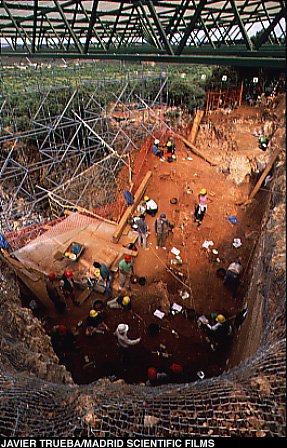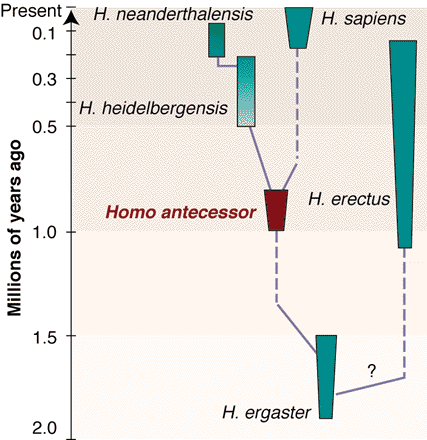view this group as evidence of a transition toward modern Homo sapiens.
 The "Mauer mandible", found in 1907 and dated at roughly 500,000 years old, combines primitive features (robusticity) with modern features (molar size), was given the species name Homo heidelbergensis in 1908. Some major findings of this species may be located at Atapuerca in Northern Spain where one of the most spectacular dings of recent times was made. They uncovered 1300 human fossils remains (representing 30 individuals) dated at 300,000 years old. These specimens also display modern and ancient features mixed, and can probably be assigned to Homo heidelbergensis.
The "Mauer mandible", found in 1907 and dated at roughly 500,000 years old, combines primitive features (robusticity) with modern features (molar size), was given the species name Homo heidelbergensis in 1908. Some major findings of this species may be located at Atapuerca in Northern Spain where one of the most spectacular dings of recent times was made. They uncovered 1300 human fossils remains (representing 30 individuals) dated at 300,000 years old. These specimens also display modern and ancient features mixed, and can probably be assigned to Homo heidelbergensis.
The main noticable features of the fossils is the more prominent face and nose and the changes at the base of the skull which are perhaps thought to be associated with changes in the voice box.
Little is known so far about how this group fitted into the
 The "Mauer mandible", found in 1907 and dated at roughly 500,000 years old, combines primitive features (robusticity) with modern features (molar size), was given the species name Homo heidelbergensis in 1908. Some major findings of this species may be located at Atapuerca in Northern Spain where one of the most spectacular dings of recent times was made. They uncovered 1300 human fossils remains (representing 30 individuals) dated at 300,000 years old. These specimens also display modern and ancient features mixed, and can probably be assigned to Homo heidelbergensis.
The "Mauer mandible", found in 1907 and dated at roughly 500,000 years old, combines primitive features (robusticity) with modern features (molar size), was given the species name Homo heidelbergensis in 1908. Some major findings of this species may be located at Atapuerca in Northern Spain where one of the most spectacular dings of recent times was made. They uncovered 1300 human fossils remains (representing 30 individuals) dated at 300,000 years old. These specimens also display modern and ancient features mixed, and can probably be assigned to Homo heidelbergensis.

